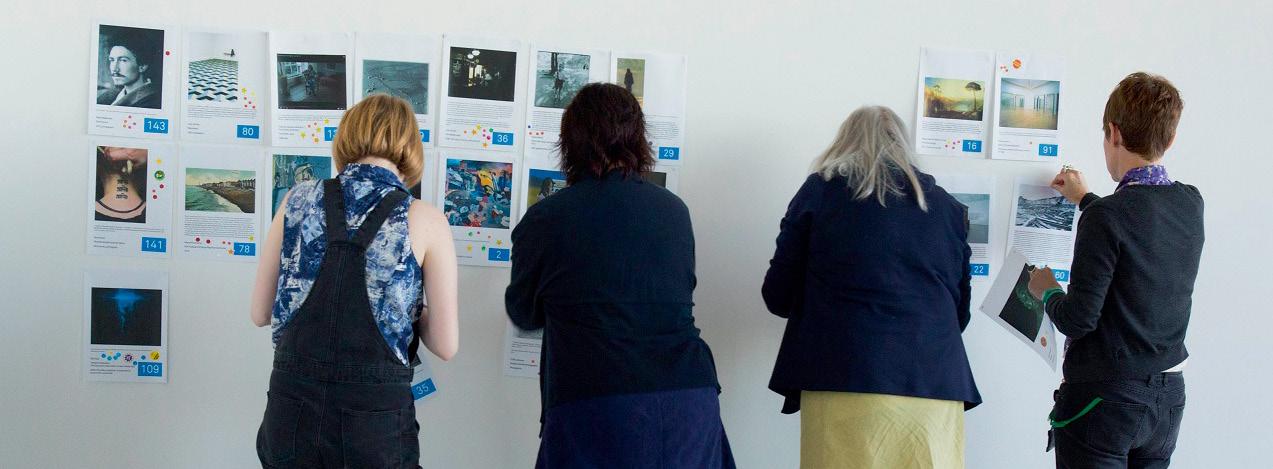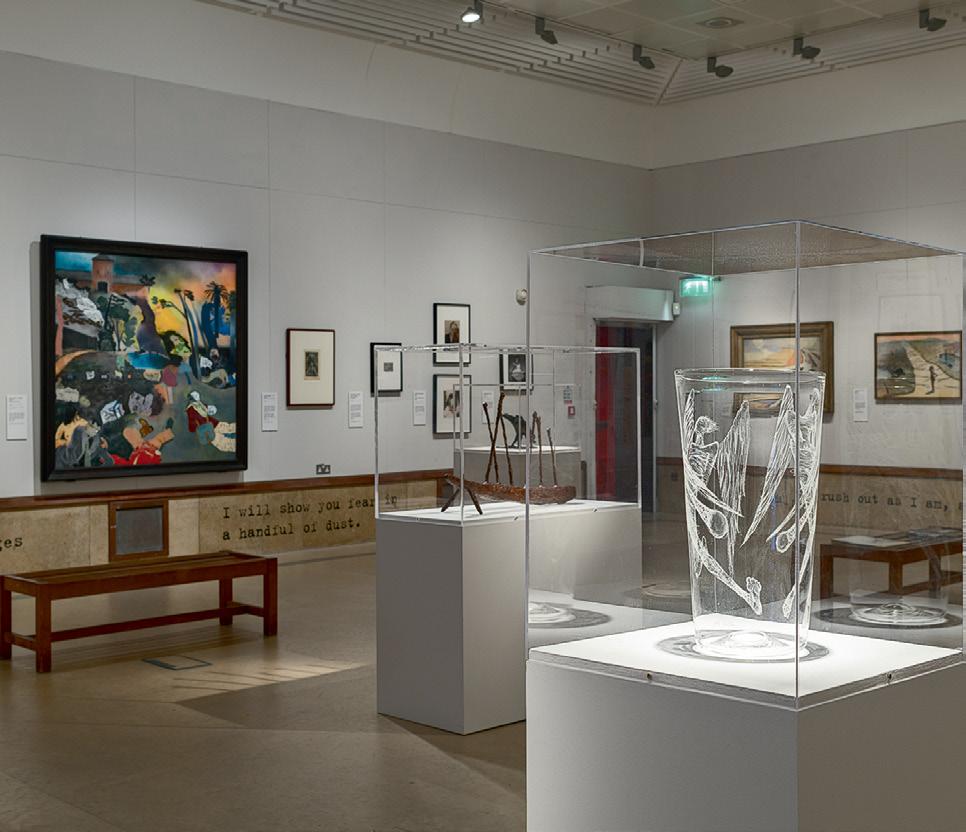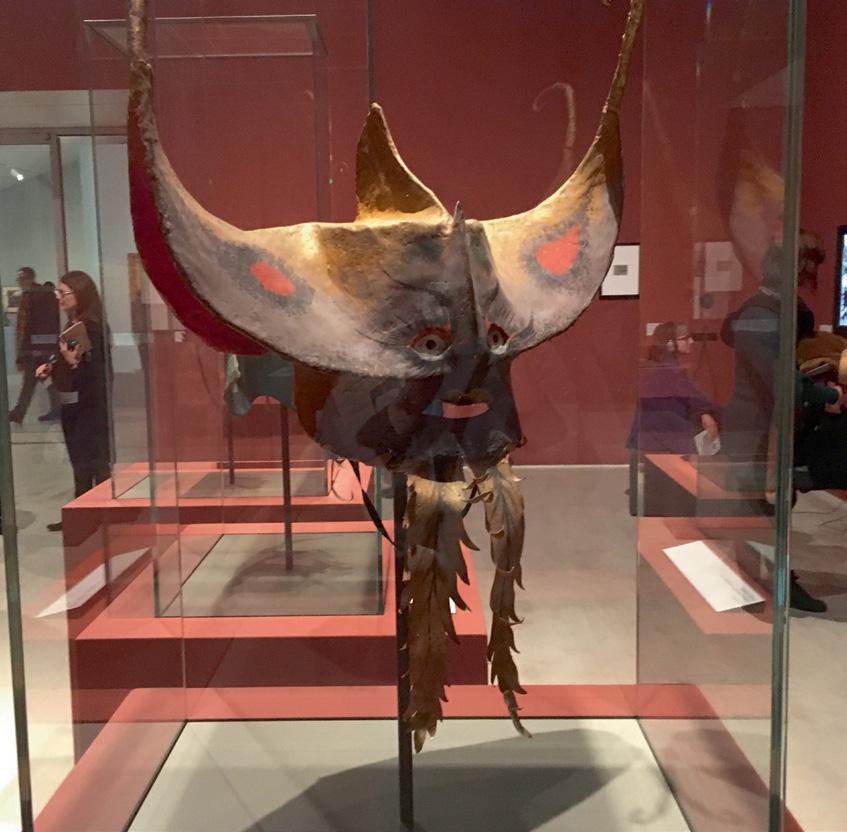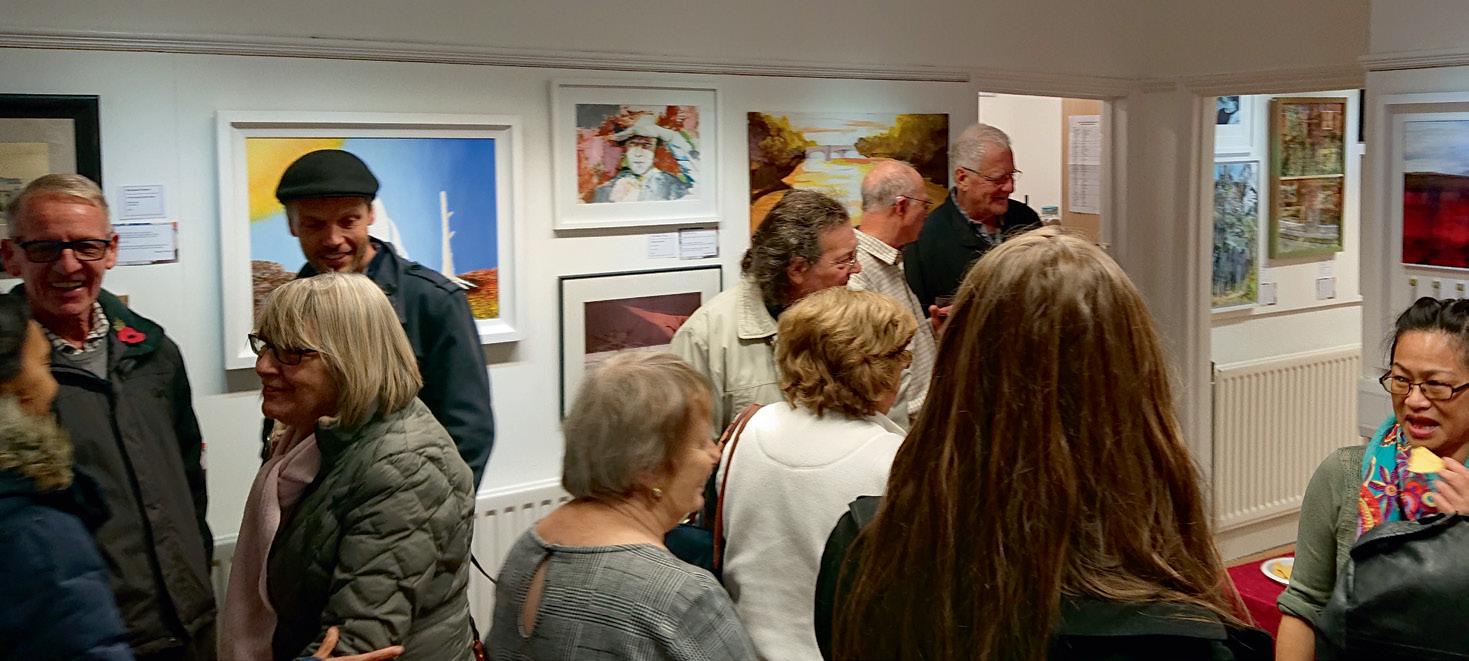
13 minute read
Community curation
A community curation journey with Karen Parker
Figure 1. Left: Coventry Research Group
Advertisement
If ever a project had your name on it Karen this is it!” Is it because I love poetry, enjoy T.S.Eliot, find delight in art, or I am an organiser? Yes to all these things, but it is my desire to promote the arts in general, to be inclusive, but mainly to engage with people, sharing my knowledge and learning from others, that drew me to the idea of a community curated art exhibition based on Eliot’s poem The Waste Land. Find a community of interested volunteers was the directive. Tricky finding willing volunteers from a diverse background, centred around Coventry and who enjoyed those same precepts of poetry and art. A widespread email to community groups and invitations through Warwick Arts Centre, Mead Gallery and social media brought a mixed group of people to the first meeting. Over time this initial group settled at around thirteen people who became the Journeys with ‘The Waste Land’ Research Group and stayed the course of the project (Fig. 1). This was in contrast to Turner Contemporary, Margate, the project starting point, where around fifty-sixty volunteers were involved.
Community is a difficult thing to identify and define. Is it defined by profession, knowledge, interest, place, age, nationality, experience, local or worldwide, virtual or in person? In the end it was a self-selected group of individuals, with many personal reasons for being involved, including prosaic considerations of time, availability, geography, commitment and expense, as well as philosophical, educational and visionary ideals. Professor Mike Tooby, the lead on the project, wanted to challenge the notion of the omnipotent curator, declaring the audience must see a definitive interpretation of a subject. The project aimed to challenge stereotypes and preconceived notions of an audience, and to encourage dialogue, harness local expertise and enthusiasm, using “socially engaged practice as outreach.” (Tooby presentation 16.11.18). This was a plea to the
communities of Coventry and Margate to get involved, to not be a passive audience, but to engage with each other and contribute to the whole experience. A different approach is sometimes met with suspicion and it is vital the process is engaging in itself, treating discussion and ideas with respect.
The groups in Margate and Coventry also worked together to maintain a sense of community through both venues, and each learned from the other swapping ideas and suggestions. So did the community embrace the project, and in return the project embrace the community, both before and during the events in both settings? Margate appeared to have struck a chord and embraced the whole town, with events and exhibitions on every street during the exhibition. Coventry was smaller and with fewer events, interesting considering the size of the city in comparison, however it may have been the vastness of the city that diluted the message to be involved. Margate definitely captured the zeitgeist and anecdotally, the reception and evaluation of the two exhibitions was encouraging, with visitor numbers extremely healthy and many positive comments (Fig. 2). Mike Tooby observes that exhibitions have been drifting into only one way to consider a subject, and questions what other ways there are to engage new audiences by altering the process of curating and involving more contribution from a wider source. The origin of the word is from the Latin curare, to take care. Apply this concept to our understanding of art curation and a broad spectrum of interpretation emerges. Is it merely choosing a selection to show together, is it stewarding a collection, is professional expertise implied, indeed how is expertise defined or necessary, or can this concept be more widely employed?
Algorithms are curating our choices in online sales, offering options based on previous purchases and suggesting they are curated for you. David Balzer claims in The Guardian “Contemporary curating has become an absurdity. Outfits are curated. Salads are curated. Twitter feeds are curated.” The Guardian Saturday 18.04.15. he goes on to say “The curator gives value to things but also, crucially, performs value–conscious of onlookers.” This describes the process of art curation, but does not define by whom. The Journeys with ‘The Waste Land’ project set out to challenge not the notion of expertise, but who it may be attributed to and where it could be found. Scholars of T.S.Eliot, art historians, poets, performance artists, visual artists, sound artists, dog groomers, builders, retired, unemployed, shopkeepers, librarians, linguists, doctors, a wide cross section of the general public in fact contributed to the Research Groups. Andrew Nairne, Director of Kettle’s Yard, states that “being curator does not require certificates. What is required is curiosity about art and creativity.” (The Art and Science of Curation). These qualities were found in abundance in the Research Groups where there was much sharing of knowledge and skills, cooperation and compromise, negotiation and decision making. Itha O’Neill, curator at Amos Anderson Art Museum, Helsinki, believes “curators are mediators of knowledge”. The Art and Science of Curation. Nairne suggests Jim Ede, founder of Kettle’s Yard “did not think he alone could or should curate, he wanted everyone to be a curator. By this he meant that we could all learn, or release, the visual awareness required to create harmony through arranging art and objects in such a way as to encourage observation and thought.”
In our community curation, curiosity, creativity and expertise provided the raw materials to tackle the question posed by Tooby: what relevance can we find in the T.S.Eliot poem The Waste Land for living today in both Margate and Coventry? Choosing The Waste Land immediately raised questions. It is considered a ‘difficult’ poem to understand and written in many voices, with many cultural references that could pass you by. Acknowledging this was paradoxically enabling and restricting, allowing many interpretations, but being obliged to remain anchored in the text. Adam Hammond says of the poem “regardless of which way you see it, its generic complexity is such that you must acknowledge that

Figure 2. Below: Margate Research Group
Figure 3 & 4. Above: Journeys with ‘The Waste Land’ Herbert Art Gallery & Museum Coventry
PHOTOGRAPH: KAREN PARKER

someone else might see it differently.” http:// hedothepolice.org. The discussion groups echoed the multivocal nature of the poem and the sharing of expertise revealed many depths and layers. This made the job excruciating to pin down on occasion, but eventually landed in a recognisable consideration for the final exhibition with many ideas and suggestions falling by the wayside.
The core of the Margate exhibition came to Coventry, but as external events began to make an impact on decisions, some works had to be left behind. We learned of the imminent rebuilding of the Mead Gallery, the intended site for the exhibition, and so in the spirit of community involvement, the Herbert Art Gallery & Museum and Coventry Cathedral, stepped in to stage the show. We were restricted on size, for instance Margate’s Cy Twombly Quattro Stagioni 1993-95 would have filled the space at the Herbert, so some work did not come to Coventry. Occasionally the work was refused by the artist, gallery or agent, and sometimes a first choice was on loan in another country. It must be remembered that some major lenders may reserve the right to restrict loans, so invariably the groups were dependent on the negotiation of professional curators. The cost of shipping and insurance proved prohibitive in some instances, and restrictions on a loan for one venue only, as in the case of the Edward Hopper Night Windows 1928, required some negotiation within the groups. The timing of requests also dictated choice, and the restrictions inherent in some works with various permissions, consideration of context, or premises were honoured. When approached, a few artists suggested a different work, and John Newling offered to create a piece Eliot’s Soil for the project, which was accepted and included pieces specifically for each venue. The community curation proved to be more than curiosity, creativity and expertise with logistics, finance and other influences ultimately impacting on decisions. The Research Groups were not at liberty to request loans directly to establishments such as the Tate, and we were beholden to the professional curators to organise loans through the accepted channels.
Coventry’s Research Group chose themes of Journeys and Fragmentation with a view to including the City’s themes of Peace and Reconciliation. Margate’s claim of Eliot writing some of the poem in the shelter on the beach, and its proximity to the sea, were specific to that venue and not so relevant to Coventry. Thus began the process of identifying artwork and artists that the


groups felt reflected the chosen themes. Local contributions were deemed important, JMW Turner The Golden Bough 1834 for Turner Contemporary in Margate, George Shaw Twelve Short Walks 2005 for Coventry, for example, and loans from local collections at the University of Warwick and Leamington Spa Art Gallery & Museum. The Research Groups visited each other and took part in some of the selection process, and a jar of Margate sand accompanied every meeting in Coventry. At Coventry, we found being the observer to an earlier process useful in streamlining ideas and identifying what we could take from Margate’s experience, so the local community was stretched as far as Margate. Some differences were illuminating. Margate chose not to declare who the voices were on their exhibition interpretation, choosing instead to record their conversations and provide audio versions. However, Coventry decided to name their contributors and have the poem recited by professional actors on a timed loop throughout the exhibition (Figs. 3, 4, 5, 6). Wanting to keep the community feel of the project and include as many people as possible, the offsite programmes were varied in both venues. Margate managed a vast selection of events across the town. It appeared that everyone was involved, not a shop or cafe escaped the exhibition and the whole town became a journey with T.S. Eliot. Discussion groups arose with reading, walking and poetry groups forming and still meeting today. Coventry’s events were fewer, reflecting the size of the Research Group where talks and performance, creating poetry and sharing knowledge were the major players. Currently new projects are being considered to keep the group together.
A popular offsite contribution was an art exhibition with a slightly different approach. Margate’s many independent art shops and galleries, cafes and hotels, chose to stage an exhibition with the same focus, T.S. Eliot and The Waste Land. Coventry’s group arranged an Open Competition Response to The Waste Land at Leamington Studio Artists East Lodge Gallery, where the brief was new work inspired by the poem. A community of thirty-five artists submitted fifty-two works of art, all of which were accepted and hung. The exhibition was entirely self-selected and therefore curated by the community. As an exercise in creating an exhibition to a theme by a community, this event succeeded in a simpler format without the complicated preamble and preparations the main exhibitions demanded. However, as a community engagement project this was less evident. There may have been conversations around the subject and process by some artists, but most submissions were made in isolation from the community (Fig. 7). Personally I found the whole Journeys with ‘The Waste Land’ experience challenging and illuminating. I have learned so much about art, artists and the art world, people in general, philosophy and poetry, community, compromise and cooperation. I have learned deliberation, negotiation and when to make a stand. I have made new friends, and discovered new skills, all generating new possibilities and opportunities for the future. I feel privileged to have been a part of such an experience. I now know my community better and it has kindled a desire to be more involved in that community (Fig. 8).

www.artandscienceofcuration.org.uk/


Feature Karen Parker is a member of the Coventry Journeys with ‘The Waste Land’ Research Group
Figure 7. Above: Response to The Waste Land at Leamington Studio Artists East Lodge Gallery
Figure 8. Left: Members of Margate and Coventry Research Groups at Coventry Cathedral
A look at the work and the various sources of inspiration for this Warwick-based artist
Born with an English and Welsh background, Kevin Parrish was born in Birmingham, Warwickshire, in 1953. Parrish’s art reflects and encompasses his various interests that had been fascinating him from an early age – music and sports, sci-fi and astronomy, art and architecture, railways, the natural world. Parrish’s background in civil and structural engineering has evidently informed his work. As a member of the Guild of Railway Artists, Parrish has had the opportunity to exhibit with them around the country. The significance behind his railway art is revealed in the wide range of sources that feature his work such as books, magazines, jigsaw puzzles, prints and postcards. Kevin has won multiple awards and prizes over the years as a fine artist pursuing his passion. The biggest award for Kevin is “sharing his art with art lovers who really appreciate what he is doing on the canvas.” He was invited to join the Mitchell Gallery in Warwick as one of their in-house artists in 2009. A further testament to his success, his artwork can be found in private art collections in the UK and overseas. The celestial has always been of interest to Parrish and is evidently reflected in his art. This is what inspires him to create most of his images through certain genre. His outer space art and the illustration of the natural world through Why Beauty Matters are manifestations of this tendency. Particular sources of inspiration for Kevin are said to be the cosmic music lyrics of Yes and The Moody Blues and the emotions these prompt him to experience. His railway and canal images, also relating to the natural world with day and night time scenes, with the moon in the sky and reflections on the ground after recent rain, further exemplify the artist’s fascination with the celestial. Furthermore, inspiration for his work was taken from watching the legendary Doctor Who from his childhood years in the early 1960s and the many elements that go with it, such as the concept of the truth and purity and morality from the Doctor himself. Why Beauty Matters successfully communicates ideas about love, beauty, and the celestial – an overarching theme in Parrish’s art (Fig.1). This piece has evidently been inspired by the two principal philosophers Parrish follows, Prince Charles and Roger Scruton. After watching Scruton’s Why Beauty Matters programme on BBC2 and re-watching Prince Charles’s Vision of Britain on video originally made in 1987, Parrish felt inspired to create something on the canvas. For him the strong message coming across from both programmes was that mankind needs a better understanding of nature. We need to work with it and be part of it, whether it be a work of art in harmony with nature or a piece of architecture in harmony with the natural world. “We seem to have gone astray which has led to so many environmental problems around the globe.” While Parrish has recently enjoyed great success with his monochrome paintings, his colour artwork images also ought to be acknowledged for the great sense of atmosphere they evoke in the viewer (Fig.2). Kevin’s railway art entitled Train on Time was chosen to be included in the Memorial Fundraising Calendar, published in late 2017

Figure 1. Above: Why Beauty Matters (2012)







